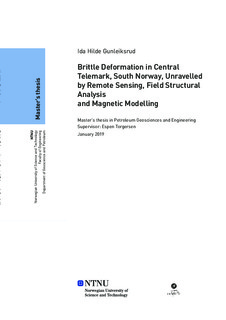| dc.contributor.advisor | Torgersen, Espen | |
| dc.contributor.advisor | Brönner, Marco | |
| dc.contributor.author | Ida Hilde Gunleiksrud | |
| dc.date.accessioned | 2019-10-15T14:02:07Z | |
| dc.date.available | 2019-10-15T14:02:07Z | |
| dc.date.issued | 2019 | |
| dc.identifier.uri | http://hdl.handle.net/11250/2622376 | |
| dc.description.abstract | Overflaten av gammelt og betydelig erodert grunnfjell er som regel tydelig kontrollert av tette forkastning- og sprekke-sett, dannet gjennom en lang og kompleks deformasjonshistorie. Denne studien undersøker sprø strukturer i et slikt grunnfjell – den svekonorvegiske bergrunnen i Drangedal and Nome, Telemark – for å forstå utviklingen av sprø deformasjon i området. I studiet blir sprø strukturer analysert på ulik skala ved ulike metoder: (1) lineamentstudie basert på topografisk og aeromagnetisk data, (2) strukturell studie av feltdata og (3) undersøkelse av magnetiske anomalier assosiert til tydelige lineamenter.
Gjennom lineamentstudiet, som var gjennomført i et separat prosjekt (Hilde Gunleiksrud, 2017), ble nesten 9000 lineamenter identifisert. Lineamentene var analysert og sortert i tre populasjoner basert på strøk-retning: (1) NE–SW, (2) NNW–SSE, and (3) NW–SE. Analyse av feltdata viser en god korrespondanse med resultatene fra lineamentstudiet, og tilfører nødvendig strukturell og kinematisk informasjon for videre klassifisering av forkastningene. Gjennom en paleo-stress inversjon ved Win-Tensor, viste deg seg at tre ulike spennings-regimer har vært sentrale i dannelsen av sprekke- og forkastningsmønsteret observert i Drangedal og Nome: (1) NW–SE ekstensjon for å danne NE–SW orienterte normalforkastninger, (2) E–W transpressjon for å danne NE–SW orienterte strøkforkastninger med dekstral bevegelse, og (3) NE–SW ekstensjon for å danne NW–SE normalforkastninger. På bakgrunn av resultatene i dette studiet blir det forslått at regime 1 er relatert til kollaps av den svekonorvegiske fjellkjede, med en reaktivering i sen trias, at regime 2 er relatert til kaledonsk kompresjon og at regime 3 er relatert til åpningen av Iapetus havet.
I forbindelse med betydelige topografiske lineamenter observeres tydelige anomale (lave) magnetfelt målinger. Ved å kombinere geofysiske-, petrofysiske-, og strukturell feltdata i en 2D modell over et slikt lineament, er det forslått at anomale magnetfelt målinger er et resultat av hydrotermal omdanning og dypforvitring. Disse prosessene er diskutert i sammenheng med den forslåtte sprø deformasjonshistorien i studieområdet. | |
| dc.description.abstract | The morphology of old and deeply eroded geological terranes are often controlled by abundant fracturing and faulting that reflects their long and often complex deformational history. This study investigates the brittle structures of one such terrane – the Sveconorwegian bedrock in the Drangedal and Nome municipalities, Central Telemark – with the aim to unravel the brittle deformational history of the area. The studied structures are investigated in a multidisciplinary and multiscalar approach comprised of (1) a remote sensing lineament study using high-resolution topographic and aeromagnetic data, (2) a structural study of field-data, and (3) an investigation of the magnetic signatures of the lineaments.
During the lineament study, which was carried out as a separate project (Hilde Gunleiksrud, 2017), nearly 9000 lineaments were identified and separated into three fault populations based on their orientations; (1) NE–SW, (2) NNW–SSE, and (3) NW–SE. Analysis of field data show a good correspondence with the remote sensing results, and provides the necessary structural, kinematic and environmental information to further constrain the fault populations into respective deformational events. Paleo-stress inversion analysis using Win-Tensor allowed for three separate stress regimes to be determined; (1) NW–SE extension creating NE–SW striking normal faults, (2) E–W transpression related to mainly NE–SW striking dextral strike-slip faults, and (3) NE–SW extension creating NW–SE striking oblique normal faults. It is proposed that regime 1 is related to the collapse of the Sveconorwegian orogen, with Late Triassic reactivation, regime 2 to E–W compression during the Caledonian orogeny and regime 3 to the rifting of Rodinia and possible Permian to Triassic reactivation.
Several of the largest topographic lineaments are associated with a pronounced low magnetic anomaly on the aeromagnetic maps. By integrating geophysical-, petrophysical- and structural field data in a 2D model across such a lineament, it is proposed that the anomalous magnetic response is due to a combined effect of hydrothermal alteration and deep weathering which ultimately reduce the magnetization of the rocks within the lineament. The alteration and weathering processes within the lineaments is discussed in context with the proposed brittle evolution (of the studied area) and a general geomorphological evolution of the region. | |
| dc.language | eng | |
| dc.publisher | NTNU | |
| dc.title | Brittle Deformation in Central Telemark, South Norway, Unravelled by Remote Sensing, Field Structural Analysis and Magnetic Modelling | |
| dc.type | Master thesis | |
